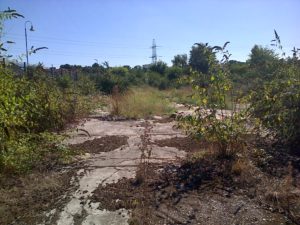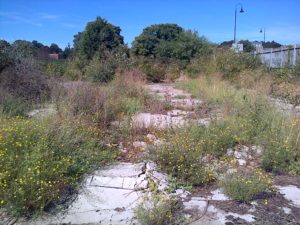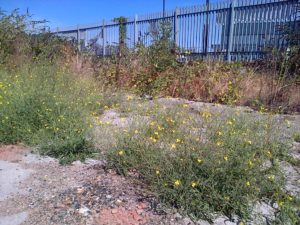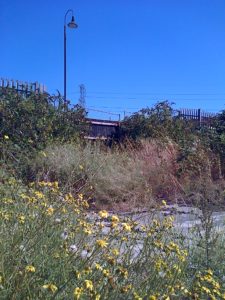A Clouded Yellow butterfly (Colias croceus), primarily an immigrant species, originating from northern Africa and southern Europe, was seen on the former Electrobase site in Crayford this afternoon (11th September). More usually a very occasional sight in our ‘coastal’ areas of Erith and Crayford Marshes, the insect flew a ‘beat’ up and down the Roman Way end of this brownfield habitat, repeatedly disappearing for some time before coming back into view. Although flying low down near the ground most ofthe time, it just would not settle, and the only record I managed to capture in which it could be seen was the first fraction of a second in an otherwise very poor mobile phone video clip.
This was a fresh-looking specimen, and although the species can breed in the UK, larvae and pupae tend not to survive our winters.

This brownfield habitat in the centre of Crayford was hosting a Clouded Yellow butterfly on 11th September 2016. (Photo: Chris Rose)

The Clouded Yellow repeatedly flew up and down this area near Roman Way, but between whiles disappeared for extended periods of time. (Photo: Chris Rose)
The site was also hosting larvae of the Small Ranunculus moth (Hecatera dysodea) which was once widespread in southern Britain but declined dramatically and was deemed extinct in the UK by around 1939. It was then found in Kent in 1997, and has since recolonised both its previous areas and further afield.
The species is strongly linked with brownfield sites as its main larval foodplant, Prickly Lettuce, is a ruderal species often found at such sites. Indeed this was the plant it was using here, with 8 caterpillars found on 5 different plants. A lot of the Lettuce were dying and crisping up in the dry, having run to seed, and none were on these. Earlier in the day a few of these caterpillars had also been found on Bourne Road allotment site on the same plant. These were my first records of the year, but most of these larvae were still well short of fully grown. In previous years I have had no trouble finding them on roadsides in places such as Bexleyheath, Barnehurst and Northumberland Heath, but had looked in vain so far this year.
On 14th April this year Bexley’s planning committee voted – on the casting vote of the Chair after a tie – to redevelop this site for housing. Not satisfied with that, the developer is also being allowed to build on 10% of Crayford Rough – a large slice of one of the best parts, with a good population of ‘Common’ Lizard, Slow Worm, Pyramidal Orchids and the only remaining Bee Orchids here.

Perennial Wall Rocket providing more food for the many Bees that were swarming around the flowers. (Photo: Chris Rose)
The ‘developer’ promises a net increase in green space, at least over what’s on the brownfield part of the proposed development footprint, but given the excessive amounts of sterile surfacing and twee, manicured ‘planting’ depicted in the artist’s impressions, and the fact that the flat roofs will have formal ‘roof gardens’ and not (according to the Design Statement documents) replacement green/brown wildlife habitat, the actual amount of biodiversity is highly likely to decrease, quite apart from the encroachment onto the Rough. Unfortunately this is a point currently beyond the comprehension of a number of Councillors on the planning committee, who in any case clearly believe – or have fallen unthinkingly for the implicit argument – that a credible way to implement the Council’s policy to ‘protect and enhance’ biodiversity in the Borough is to leave it ever less space to live in.
Ironically there are way more resources for pollinators on this piece of ‘brownfield’ at present than in many of Bexley’s parks, where our public money, which the Council says it no longer has enough of, is still being spent on heavily suppressing the amount of wildlife. Through a combination of mowing, low floral diversity and very dry conditions most have very few flowers available at all at present, just swathes of largely boring short grass.
Chris Rose


Just found this page after receiving a flier today for consultation on new development of former electrobase site. At this stage how can we best influence the consultation process to improve biodiversity of the development?
Sorry for the delay in responding, I missed your email. There should be the opportunity to comment on the application, perhaps mentioned in the leaflet?
You can comment directly on planning applications through the Council’s website at https://www.bexley.gov.uk/services/planning-and-building-control/view-and-comment-planning-applications/viewing-planning-applications.
I found the application by searching on electrobase.
I am not quite sure what the status is now. I’ve also sent your email to my colleague Chris Rose who is more up to date on planning applications.
Regards
Jonathan Rooks